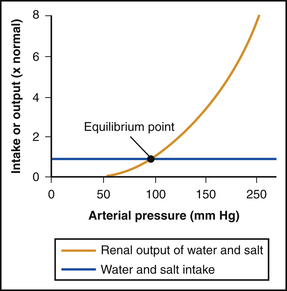17 CASE 17
A 60-year-old woman being treated for hypertension returns to her physician’s office for treatment.
PHYSICAL EXAMINATION
LABORATORY STUDIES
PATHOPHYSIOLOGY OF KEY SYMPTOMS
The kidneys are a major determinant of arterial blood pressure through the regulation of body fluid volume. This regulation is evidenced by both pressure diuresis and pressure natriuresis, where a decrease in renal perfusion pressure results in the retention of both sodium and water (Fig. 17-1).
A stenosis in the renal artery introduces a preglomerular vascular resistance and decreases glomerular capillary pressure. The decrease in glomerular capillary pressure results in the fall in glomerular filtration rate and the shift toward retention of sodium and water. Retention of water and sodium causes an increase in systemic arterial blood pressure; and as soon as the blood pressure is sufficiently high, glomerular capillary pressure returns to normal. In this instance, sodium and water are in balance but only because the patient is hypertensive. For example, aortic stenosis above the origin of the renal arteries will result in hypertension but aortic stenosis below the origin of the renal arteries will not cause hypertension (Fig. 17-2).
< div class='tao-gold-member'>
Stay updated, free articles. Join our Telegram channel

Full access? Get Clinical Tree




